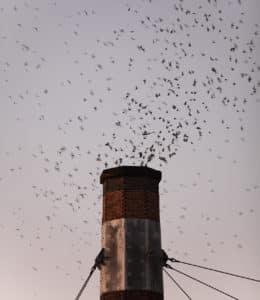Vaux’s Swifts
Vaux’s Swifts are truly amazing aerialists. They spend much of the time in the air and forage, drink, court, collect nesting materials and copulate all in flight. They have a voracious appetite for flying insects and ballooning spiders. Vaux’s Swifts arrive in Oregon in late April, court their mates in May and June, and have their 4-6 eggs laid and hatched by July.
In the fall, swifts congregate in large groups as they prepare for their migration southward to Central America and Venezuela. During September, large groups of swifts pass through the Portland-Vancouver metropolitan region.
Vaux’s Swifts look like small, dark, fast-flying cigars with wings. Their small bodies are 4-5 inches in length. Their wings are crescent-shaped and beat with swift, rapid, bat-like movements. Swifts do not “perch,” and are found flying or clinging to vertical surfaces such as trees and chimneys.
Chimneys for Roosts & Nests
- It is not uncommon for these swifts to use chimneys to roost in during the night, and once a population of swifts locates an appropriate chimney, they are likely to return year after year. Groups of roosting swifts can range in size from just a few individuals to as many as 35,000 in some larger smokestacks.
- Chapman Elementary School in northwest Portland houses the largest known roost of migrating Vaux’s Swifts in the world! Typically the swifts will only stay a couple of weeks before continuing their migratory journey.
- Vaux’s Swifts typically nest in old growth forests in hollow tree snags. Because of dwindling old-growth forest stands, Vaux’s Swifts have begun substituting chimneys for snags. Their nests are made of twigs that have been pasted together with saliva on the side of the snag or chimney. Adults access the nest by flying in and out of the top of the chimney. Swift nests disintegrate soon after they are abandoned and do not pose a fire hazard.

Common Situations or Concerns
Baby Birds in Your Fireplace
After hatching, the young are cared for in the nest for just over two weeks. As they develop, the nestlings become adventurous and begin to cling to the wall near the nest and take short flights. Sometimes they become a bit too adventurous and end up in your fireplace. If you find a young swift in your fireplace, gently reach up into your chimney and attach it to the chimney wall. Swifts have “Velcro”-like feet and will inch their way back up to their nests. Remember to close your flue as soon as you have returned the bird to the chimney interior.
Nest of Baby Birds in Your Fireplace
If a nest of young has fallen into your fireplace, place the nest in small box or berry basket. Attach the basket near the top of a piece of wood that is at least 5 inches wide and 3 or 4 feet long. Carefully raise the board into the chimney, rest the board on the damper and lean it against the inside chimney wall. The nest should be as high as possible in the chimney, allowing the parents to fly down the chimney and feed the young.
Wait a few hours for the parents to locate the nest, then listen for the loud chattering of the young as a parent enters the chimney with food. When the adult leaves it is silent again until the parent returns with food.

The Swifts in Your Chimney are Noisy!
The best thing to do is just have patience. Both during nesting and migration swifts are unlikely to remain in a chimney for more than 2-3 weeks. Removal of nesting swifts from a chimney is almost certain to lead to the death of the nestlings. Swifts are highly specialized birds, and it is almost impossible to raise them in captivity. Their only chance for survival is to be left inside the chimney to be cared for by their parents.
What You Can Do to Help Vaux’s Swifts
If you know you have a nest of Vaux’s Swifts in you chimney (usually known by the loud chattering of the young as the parents enter with food), here are some things you can do to help them. Delay starting a fire in your fireplace or having your chimney swept until the parents and the young have left the nest, usually by September or October.

